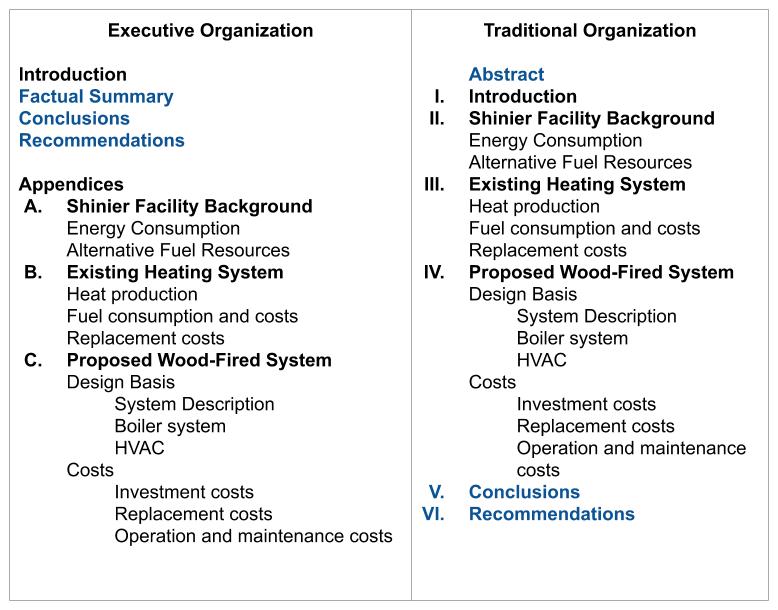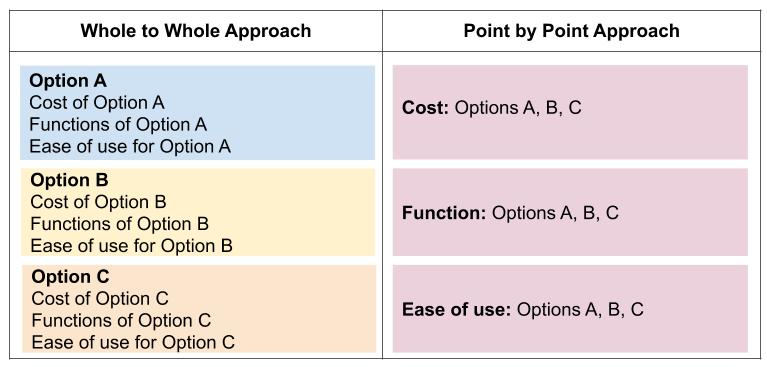12.5 Recommendation Reports
Recommendation reports provide carefully studied opinions and recommendations. This type of report starts from a stated need, a selection of choices, or both and then recommends one, some, or none. For example, a company might be looking at grammar-checking software and want a recommendation on which product is the best. As the report writer on this project, you could study the market for this type of application and recommend one particular product, a couple of products (differing perhaps in their strengths and their weaknesses), or none (maybe none of them are any good). The recommendation report answers the question “Which option should we choose?” (or in some cases “Which are the best options?) by recommending Product A, or maybe both Products A and B, or none of the products.
Organizational Plans for Recommendation Reports
Recommendation reports are generally organized in one of two ways (see Figure 12.1):
- Traditional plan: You start with background and requirements, then move to comparisons, and end with conclusions and recommendations.
- Executive plan: This one moves the conclusions and recommendations to the front of the report and pitches the full discussion of background, requirements, and the comparisons into appendices. That way, the “busy executive” can see the most important information right away, and turn to the detailed discussion only if there are questions.

Typical Contents of Recommendation Reports
The structural principle fundamental to this type of report is this: you provide not only your recommendation, choice, or judgment, but also the data and the conclusions leading up to it. That way, readers can check your findings, your logic, and your conclusions and come up with a completely different view. But, more likely, they will be convinced by all your careful research and documentation. The report can be organized using the Whole to Whole approach from Activity 12.5 or the Point by Point approach shown in Activity 12.6. Both approaches will be discussed in more detail in the next section.
Activity 12.5 | Recommendation Report- Whole to Whole Approach- Reproduced with permission from T. Akar (2019)
Introduction
In the introduction, indicate the purpose of the report: discuss the problem, need, or opportunity that has brought about the report. In addition, briefly explain the data collection method.
Significance of Situation
Explain how this problem or situation affects your organization and the importance of finding a solution. Do research to build a strong argument around the impact of the problem.
Requirements and Criteria
A critical part of recommendation reports is the discussion of the requirements you’ll use to reach the final decision or recommendation. For example, if you’re trying to recommend a tablet computer for use by employees, your requirements are likely to involve size, cost, hard-disk storage, display quality, durability, and battery function.
The requirements section should also discuss how important the individual requirements are in relation to each other. Picture the typical situation where no one option is best in all categories of comparison. One option is cheaper; another has more functions; one has better ease-of-use ratings; another is known to be more durable. Set up your requirements so that they dictate a “winner” from a situation where there is no obvious winner.
Discussion of the Options
In certain kinds of recommendation reports, you’ll need to explain how you narrowed the field of choices down to the ones you focus on in your report. Often, this follows right after the discussion of the requirements. Your basic requirements may well narrow the field down for you. But there may be other considerations that disqualify other options—explain these as well.
Additionally, you may need to provide brief descriptions of the options themselves. Don’t get this mixed up with the comparison that comes up in the next section. In this description section, you provide a general discussion of the options so that readers will know something about them. The discussion at this stage is not comparative. It’s just a general orientation to the options. In the tablets example, you might want to give some brief, general specifications on each model about to be compared.
Comparison Approaches
One of the most important parts of a recommendation report is the comparison of the options. Remember that you include this section so that readers can check your thinking and come up with different conclusions if they desire. This can be handled with a comparative point by point option or a comparative whole to whole option depending on the situation. Figure 12.2 compares both approaches.

When do you use the point by point approach? The point-by-point approach is effective when the alternatives can be broken down into categories. If you are comparing tablets, you’d have a section that compared them on cost, another section that compared them on battery function, and so on. You wouldn’t have a section that discussed everything about option A, another that discussed everything about option B, and so on. That would not be effective at all, because the comparisons must still be made somewhere—probably by the reader. With the point-by-point approach, each of these comparative sections should end with a conclusion that states which option is the best choice in that particular point of comparison. Of course, it won’t always be easy to state a clear winner—you may have to qualify the conclusions in various ways, providing multiple conclusions for different conditions.
When do you use the whole to whole approach? The whole to whole approach is useful when the comparisons don’t break down logically into points or categories. The options being compared might have different advantages and disadvantages that are not comparable. In this situation, it is best to describe each option in detail, including the advantages, limitations and costs (is applicable). In the conclusion, you’d include comparison and analysis of the different options.
Summary table
After the individual comparisons, include a summary table that summarizes the conclusions from the comparison section, if appropriate. Some readers are prone to pay attention to details in a table rather than in paragraphs.
Conclusions
The conclusions section of a recommendation report is in part a summary or restatement of the conclusions you have already reached in the comparison sections. In this section, you restate the individual conclusions, for example, which model had the best price, which had the best battery function, and so on. This section must untangle all the conflicting conclusions and somehow reach the final conclusion, which is the one that states which is the best choice. For example, if one tablet is the least expensive but has poor battery function, but another is the most expensive and has good battery function, which do you choose, and why? The conclusion would state the answer to this dilemma.
Recommendation
The final section of a recommendation report states the recommendation. You’d think that that ought to be obvious by now. Ordinarily it is, but remember that some readers may skip right to the recommendation section and bypass all your hard work! Also, there will be some cases where there may be a best choice, but you wouldn’t want to recommend it. Early in their history, laptop computers were heavy and unreliable. There may have been one model that was better than the rest, but even it was not worth having. The recommendation section should echo the most important conclusions leading to the recommendation and then state the recommendation emphatically as demonstrated in Activity 12.6.
Activity 12.6 | Recommendation Report- Point by Point Approach
Checklist for Recommendation Reports
As you reread and revise your recommendation report, keep in mind the following:
- Write a good introduction in which you indicate the situation and the audience and provide an overview of the contents.
- Discuss the background on the problem or opportunity—what brought about the need for the report.
- State requirements—those factors that influence the decision or the choice of options. (And remember to state how important the requirements are in relation to each other.)
- Organize the comparison of the options using the point by point approach or whole to whole approach.
- Include a summary table, if possible, in which you summarize all the key data in table form.
- Include a conclusions section where you restate all the key conclusions from the comparison section.
- Include a recommendation section where you make the recommendation. Briefly mention the key factors influencing the recommendation.
- Include your references section so that the reader can refer to your sources.
- Proofread and revise for grammar, mechanics and style

